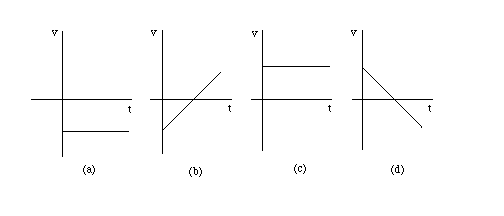
Question
Physics 211 - The questions this week and the next few weeks will deal with the concepts of velocity and speed and their relationships to position, displacement, and distance travelled. (Graphs.)
Velocity. For an object moving along an x-axis, the object's velocity v at a given instant can be defined as the slope of the object's position vs. time graph at that instant.
To find the slope of a position vs. time graph at a given point, draw the tangent to the graph at that point and take the slope of that tangent. The tangent to a curve at a point is the (unique) straight line that touches the curve at that point, but does not intersect it.
The velocity at a given instant can be either positive or negative or zero, depending on whether the x vs. t graph is rising, horizontal, or falling at that instant.
Speed. The speed of an object at a given instant is equal to the magnitude (absolute value) of the velocity. Thus, if the velocity is 20 m/s, the speed is also 20 m/s. If the velocity is -20 m/s, the speed is still 20 m/s. Thus velocity and speed are not always the same, and one must distinguish between the two concepts.
Question. Draw velocity vs. time graphs for all four displacement vs. time graphs shown below. (These are the same graphs as in the July 11, 1997 question.) You may assume the position x at time t to be zero so that the position x at time t is equal to the displacement Dx at time t as shown in the graphs.
You can draw the v vs. t graphs only qualitatively since no units are indicated on the axes. However, the graphs should be qualitatively correct. For example, if the position vs. time graph has a slope that is decreasing (as t is increasing), the corresponding v-values on the v vs. t graph should be decreasing as well.
Discuss what kind of a motion a hiker would have to perform if she walked as graph (d) suggests. Is this a realistic motion for a hiker?

Answer
The four velocity vs. time graphs are shown below.

The explanation of why these are the correct graphs will not be provided today. Try to come up with your own explanation. The explanation will be provided next week.
A hiker who moves according to graph (d) would start out with a positive velocity while walking in the positive x-direction away from the camp. She would gradually slow down and come to a stop momentarily at the point farthest from the camp. Here she would turn around and then walk back towards the camp (now moving in the negative x-direction), gradually increasing her speed, until she is fastest upon returning to the camp. An unsual way of walking!